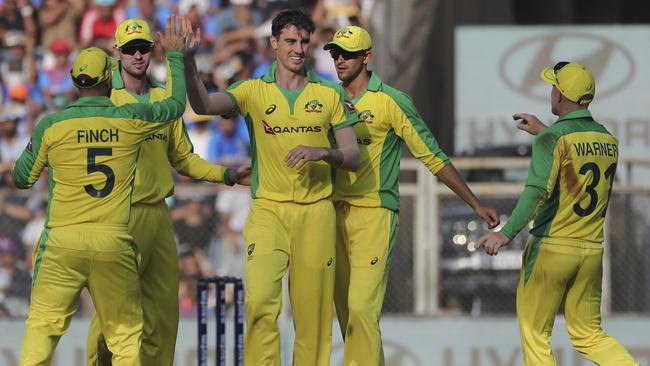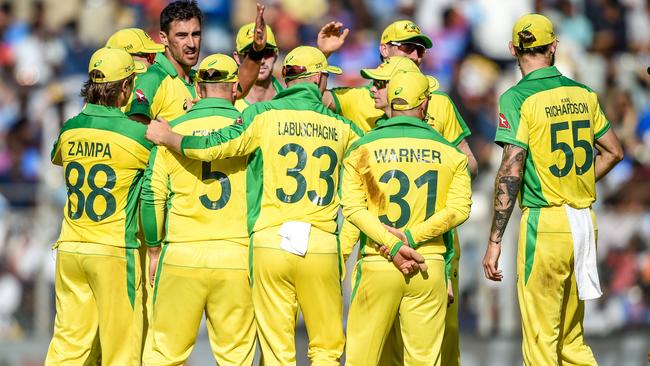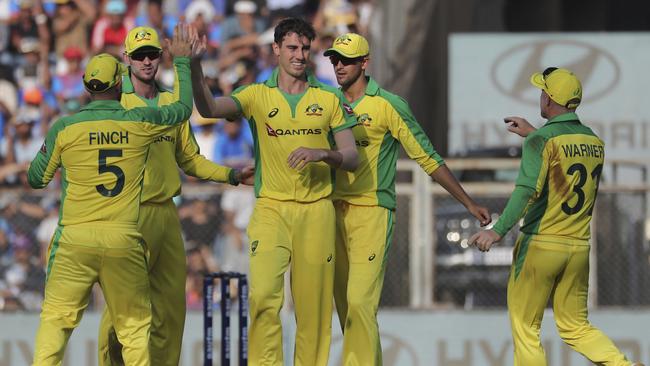Ian Chappell: Cummins, Starc, Hazlewood and Pattinson give Australia big advantage
Pace and bounce! It’s a proven match-winning commodity in all forms of the game, and all conditions, and the Aussies currently have the talent to deploy it at will, says IAN CHAPPELL.

Cricket
Don't miss out on the headlines from Cricket. Followed categories will be added to My News.
- Maxwell’s ODI axing leaves former captain stunned
- AB hints at another Aussie stint … in Proteas colours
It’s widely accepted pace bowling is a difference maker in Test cricket.
Combinations such as Ray Lindwall and Keith Miller, Frank “Typhoon” Tyson and Brian Statham, Dennis Lillee and Jeff Thomson, Andy Roberts and Michael Holding — just the mention of those names still induces a whiff of terror among ageing batsmen around the world.
Australia currently has a formidable pace quartet in Pat Cummins, Mitchell Starc, Josh Hazlewood and James Pattinson that’s the envy of the cricket world.
Stream the Qantas Tour of India LIVE & On-Demand on KAYO with FOX CRICKET’s unmatched commentary line-up. New to Kayo? Get your 14-day free trial & start streaming instantly >

Two of those men — Cummins and Starc — showed in the opening match in India that good fast bowling can also make a difference in ODIs. It was the pair’s pace and bounce that unsettled the Indian batsmen on a Mumbai pitch that was only slightly helpful.
However, the Indians greatly contributed to their own downfall by perpetrating a huge blunder before a ball was bowled. The decision to bat their maestro Virat Kohli at four was ill-conceived and lacked cricketing logic.
Kohli is well equipped to take on the likes of Starc and Cummins and do it successfully. If he dominates — as he did in the second contest when sanity prevailed and he returned to his rightful No. 3 spot — it forces Aaron Finch to use up more of the Starc and Cummins overs early on in an attempt to combat Kohli.
As a consequence, this puts a lot more stress on the remainder of the Australian attack, and it was the leg-spinner Adam Zampa who held up best under pressure.
Kohli and the experienced opener, Rohit Sharma, are the Indians best equipped to put an end to any short-pitched shenanigans. On a flat pitch in Rajkot and with the skipper appearing at three, Australia’s short-pitched strategy was successfully blunted.
I once asked former Aussie tennis grand slam winner John Newcombe about serve-volleying on clay courts. His response was; “Serve-volley is a state of mind. You have to accept you’ll be passed a few times.”

Taking on fast, short-pitched bowling is also a state of mind. A player who regularly tackles the hook shot has to accept he’ll be dismissed in that manner occasionally. It’s a matter of the player assessing whether the shot is profitable enough — both in runs and psychological advantage — to continue playing it.
Both Kohli and Rohit have the skill and the nerve to retaliate when the fast men start delivering bouncers, and these bowling tactics are best blunted early in an innings.
In the first contest, without protection from either Kohli or Rohit, the up-and-coming Shreyas Iyer was given an inkling of what some of the younger Indian batsmen can expect in Australia next summer.
He was bounced unceremoniously by Cummins and Starc only to succumb to a full delivery from the left-armer.
This is standard fare in Australian conditions, so any young Indian batsman with an eye on the prize of a tour Down Under had better start preparing for a similar psychological examination.
With that eagerly-awaited clash in mind, the Australians may have also uncovered a clue for their strategy against the ever-dangerous Kohli. Zampa dismissed Kohli in each of the first two contests to give him the enviable record of having ambushed the leading ODI batsman five times.

This may cause the Australians to give greater consideration to including young leg-spinner Mitchell Swepson at the appropriate time in next summer’s Test series. Finding a way to fit him into the XI will provide the selectors with a head-scratching challenge.
However, as these two highly competitive and entertaining teams head to Bengaluru for the deciding contest, thoughts will be concentrated purely on how to win the trophy rather than gain any future psychological advantage.
There’s very little between these two teams and Australia’s record of four consecutive wins in India before the reversal in Rajkot, shows just how competitive the ODI side is in all conditions.
In a format where matches can be decided by individual performance as often as a team combining well, both sides have a sprinkling of match winners.
The willow-wielding matchwinners are equally divided between the two teams, but it’s in pace where Australia hold an advantage.
The extra bounce of Cummins and Starc is Australia’s best chance of restricting the damage caused by India’s star-studded top order.
If the Australian pair are successful in Bengaluru, it will prove that pace can put you on top anywhere, not just Down Under.
